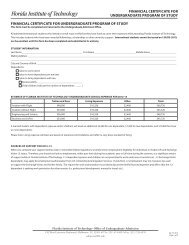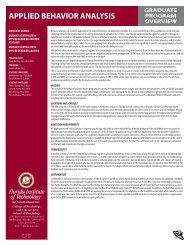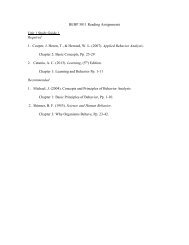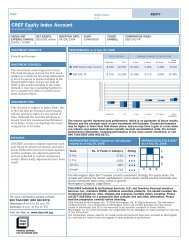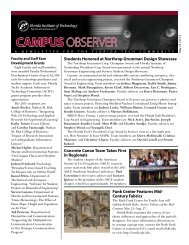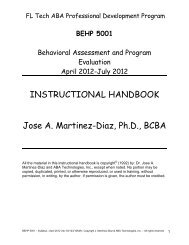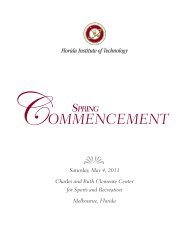2006–2007 - Florida Institute of Technology
2006–2007 - Florida Institute of Technology
2006–2007 - Florida Institute of Technology
You also want an ePaper? Increase the reach of your titles
YUMPU automatically turns print PDFs into web optimized ePapers that Google loves.
interactions using data from LEP, the world’s highest energy<br />
electron-positron accelerator. The CMS experiment will operate<br />
at CERN’s large hadron collider, which will provide the world’s<br />
highest energy proton-proton collisions, beginning 2007. We<br />
have taken responsibilities in the laser calibration system for the<br />
forward hadron calorimeter and the alignment <strong>of</strong> the forward<br />
muon system, including design, building, testing, integration,<br />
commissioning, operations, s<strong>of</strong>tware and data analysis.<br />
With the D-zero experiment at the Fermi National Accelerator<br />
Laboratory (Chicago, Ill.), we are investigating perturbative QCD<br />
by confronting its predictions with measurements <strong>of</strong> b-quark<br />
cross section using dimuon events produced in proton-antiproton<br />
collisions.<br />
At the Brookhaven National Laboratory in Long Island, N.Y., we<br />
are a member <strong>of</strong> the PHENIX collaboration investigating interactions<br />
at the Relativistic Heavy Ion Collider (RHIC), providing<br />
the highest accelerator energies for nuclei. The most exciting goal<br />
<strong>of</strong> RHIC is the discovery <strong>of</strong> the quark-gluon plasma, a state <strong>of</strong><br />
matter, which is hypothesized to have existed in the early phase<br />
<strong>of</strong> the universe.<br />
Detector research and development is presently focused on the<br />
application <strong>of</strong> the gas electron multiplier (GEM) technique to<br />
particle physics, medicine, and other areas such as security. The<br />
High-Energy Physics Laboratory is also a host to the “<strong>Florida</strong><br />
Tech Grid Initiative” to participate in the development and use<br />
<strong>of</strong> the emerging worldwide computing grids. Due to the technical<br />
nature <strong>of</strong> our research, the High-Energy Physics Laboratory is<br />
well suited for participation <strong>of</strong> students from other majors, such<br />
as computer science and engineering, including undergraduates.<br />
Maglev Laboratory: The primary goal <strong>of</strong> this laboratory is<br />
the development <strong>of</strong> a new space launch system for manned and<br />
unmanned missions based on electromagnetic acceleration<br />
and levitation, in cooperation with NASA, the <strong>Florida</strong> Space<br />
<strong>Institute</strong>s, and the Advanced Magnet Laboratory, a high-tech<br />
industry partner. It houses a 43-foot magnetic levitation and propulsion<br />
demonstration track, one <strong>of</strong> a handful <strong>of</strong> such devices in<br />
the country, and the only one at an academic institution. Physics,<br />
space science and engineering students and faculty, together with<br />
researchers from the other institutions, are performing investigations<br />
in topics such as controls, aerodynamics, mechanical stability,<br />
superconducting technology and electromagnetic acceleration<br />
and levitation, to study the feasibility <strong>of</strong> maglev launch assist for<br />
rockets and future spacecraft. Some <strong>of</strong> the work is also related to<br />
maglev based transportation systems. The laboratory also houses<br />
a 20-foot maglev track model built by <strong>Florida</strong> Tech students.<br />
Scanning Probe Microscopy Laboratory: This facility<br />
provides researchers with the ability to image the surface structure<br />
<strong>of</strong> a solid, and to probe the electronic surface properties <strong>of</strong><br />
a material down to the atomic scale, using a scanning tunneling<br />
microscope (STM). This laboratory also investigates novel<br />
applications <strong>of</strong> the STM (e.g., in the field <strong>of</strong> electrochemistry)<br />
and is interested in the development <strong>of</strong> other types <strong>of</strong> scanning<br />
probe microscopes.<br />
Computational Facilities<br />
The department’s facilities include a network <strong>of</strong> Linux and<br />
Windows workstations. The university also has available a 48node<br />
Beowulf cluster running Linux/MPI.<br />
Interdisciplinary Research<br />
in Physics and Space Sciences<br />
Terrestrial geomagnetic research is aimed at extracting long-term<br />
periodicities in changes in Earth’s magnetic field and correlation<br />
between secular changes in the geomagnetic field and fluctuations<br />
in the length <strong>of</strong> the day.<br />
Auroral and magnetospheric research is being done using data<br />
from polar orbiting satellites. Current work concentrates on auroral<br />
electron and proton precipitating particle energies, intensities<br />
and distribution in latitude, with relation to magnetic substorms<br />
in the magnetosphere. Space-based energetic particle observations<br />
are aimed at understanding acceleration and propagation <strong>of</strong><br />
particles in the heliosphere.<br />
In addition, the department’s space science laboratories are<br />
used by physics students from time to time. See the “Research<br />
Facilities” listing under Space Sciences.<br />
Teaching and Research Assistantships<br />
The department <strong>of</strong>fers a number <strong>of</strong> teaching and research assistantships<br />
each year. Teaching assistants participate in laboratory<br />
instruction or in the preparation <strong>of</strong> teaching materials. Research<br />
assistants work on research projects that are <strong>of</strong>ten related to their<br />
own master’s thesis or doctoral dissertation investigations. Both<br />
types <strong>of</strong> assistantships are awarded on a competitive basis, and<br />
provide graduate course fee remission and a stipend for living<br />
expenses. To increase the probability <strong>of</strong> receiving an assistantship,<br />
applicants are advised to apply as early as possible in the<br />
academic year prior to requested admission.<br />
Science Education<br />
DEPARTMENT OF SCIENCE AND MATHEMATICS EDUCATION<br />
D.E. Cook, Ph.D., Head<br />
Bachelor <strong>of</strong> Science<br />
Options in:<br />
Biology<br />
Chemistry<br />
Earth and Space Sciences<br />
General Science<br />
Physics<br />
Master <strong>of</strong> Science<br />
Concentrations in:<br />
Biology<br />
Chemistry<br />
Environmental Science<br />
General Science<br />
Oceanography/Earth Science<br />
Physics<br />
Option in:<br />
Informal Science Education<br />
Specialist in Education<br />
Doctor <strong>of</strong> Education<br />
Doctor <strong>of</strong> Philosophy<br />
Major Technical Areas in:<br />
Aeronautics<br />
Biology<br />
Chemistry<br />
College <strong>of</strong> Science–Physics, Science Education 141




